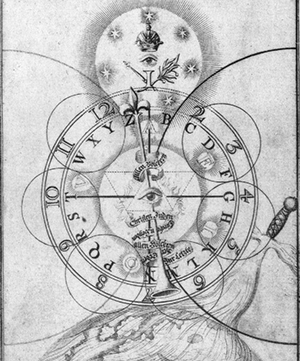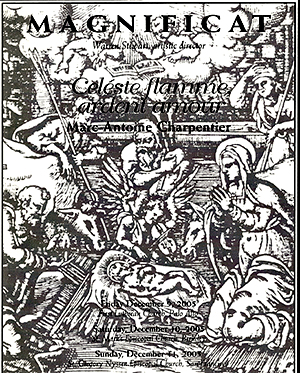2005-2006 – Magnificat’s 14th Season
 Magnificat’s 2005-2006 featured music by two composer, by then quite familiar to our audiences, Schütz and Charpentier, a less familiar name, Johann Rosenmüller and program featuring a variety of composers’ settings of text from Guarini’s Il Pastor Fido that opened the season. The season also marked the debut of the Magnificat blog as part of a new website designed by creative director Nika Korniyenko. The frontispiece the collected works of Jakob Böhme, published in Amsterdam in 1682, served as the basic image for the season brochure.
Magnificat’s 2005-2006 featured music by two composer, by then quite familiar to our audiences, Schütz and Charpentier, a less familiar name, Johann Rosenmüller and program featuring a variety of composers’ settings of text from Guarini’s Il Pastor Fido that opened the season. The season also marked the debut of the Magnificat blog as part of a new website designed by creative director Nika Korniyenko. The frontispiece the collected works of Jakob Böhme, published in Amsterdam in 1682, served as the basic image for the season brochure.
“A pastiche of little madrigals” is how Gaspare Murtola described Guarini’s Il Pastor Fido in 1626, and while his comment was intended as derogatory, he succeeding in pointing both to the strength and weakness of the play. The overblown and self-consciously poetic language of Guarini’s tragicomedy succeeded in making the play a relative failure on the stage, tremendous success as a work of literature, and a goldmine for composers seeking affective, emotional texts through which to display the new compositional techniques of the early baroque. The order of the program was determined by Guarini’s play, with settings by Sigismondo d’India, Claudio Monteverdi, Tarquinio Merula, Alessandro Grandi, and Giovanni Ghizzolo. In his review for the San Francisco Classical Voice, Joseph Sargent noted “Magnificat displayed impressive command in the ensemble madrigals, their faultless intonation and carefully matched phrasing adding greatly to this music’s effectiveness.”
 For our Christmas concert, Magnificat returned to one of our most beloved programs, the Nativity Pastorale of Marc-Antoine Charpentier. An arrangement interpolating traditional French noels into Charpentier’s histoire sacrée, this program has been featured on Magnificat’s series four times, most recently in 2012. In each revival, audiences and musicians alike are struck by the sheer beauty of Charpentier’s contrapuntal technique, the profound simplicity of the timeless noels and the exuberance and sensuality revealed in their juxtaposition.
For our Christmas concert, Magnificat returned to one of our most beloved programs, the Nativity Pastorale of Marc-Antoine Charpentier. An arrangement interpolating traditional French noels into Charpentier’s histoire sacrée, this program has been featured on Magnificat’s series four times, most recently in 2012. In each revival, audiences and musicians alike are struck by the sheer beauty of Charpentier’s contrapuntal technique, the profound simplicity of the timeless noels and the exuberance and sensuality revealed in their juxtaposition.
Writing for the San Francisco Classical Voice, Michelle Dulak Thomsen observed that “[o]ther Bay Area early-music ensembles visit the 17th century from time to time, but Magnificat is the only one of its size that practically dwells there, and it seems to be even more thoroughly at home with each performance. Certainly Saturday’s performance at St. Mark’s in Berkeley was a marvel of ease, balance, and brilliance.”
In January, 2006, Magnificat turned to Heinrich Schütz. Following on a very enjoyable program drawn from the composer’s first collection of Symphoniæ Sacræ in the 2003-2004 season, this program featured music from Symphoniæ Sacræ II, published in Dresden in 1647. Including works composed by Schütz over the almost two decades since his second trip to Venice, the collection represents the fullest example of the blending of the “new music” he had heard in Italy with the German language.
The collection differs from the first Symphoniæ Sacræ in its generally dark themes and more subdued tone, no doubt a reflection a desperation of war-ravaged Germany. Rebekkah Ahrendt commented on this darker tone in her review noting “Stewart’s programming was impeccable as usual for this concert. With his team of musicians who have long been together, Stewart, through the music of Schütz and his friends, showed that even in a time of war, friendship, hope, and art can endure. That is the message I took home from this concert; I hope others did as well.”
 The final concerts of the season featured psalms and a Magnificat by the remarkable Johann Rosenmüller, who perhaps better than any composer of the period embodies the amalgamation of German temperament and Italian style. The program followed the vespers liturgy for the Feast of the Annunciation, and also included psalm settings by Cavalli and Rovetta, with Rosenmüller’s instrumental sonatas as antiphon substitutes. Writing for the San Francisco Chronicle, Joshua Kosman noted the effect of he antiphon substitution “As Warren Stewart, Magnificat’s visionary artistic director, noted in a preconcert lecture, 17th century Italians “spent a lot of effort to make going to church as much like going to a concert as possible.” Nowadays, he added ruefully, he spends his time trying to make going to a concert as much as possible like going to church — “and all in the name of authenticity!” … The performance, by a quintet of strong singers and a small instrumental consort, was first-rate.”
The final concerts of the season featured psalms and a Magnificat by the remarkable Johann Rosenmüller, who perhaps better than any composer of the period embodies the amalgamation of German temperament and Italian style. The program followed the vespers liturgy for the Feast of the Annunciation, and also included psalm settings by Cavalli and Rovetta, with Rosenmüller’s instrumental sonatas as antiphon substitutes. Writing for the San Francisco Chronicle, Joshua Kosman noted the effect of he antiphon substitution “As Warren Stewart, Magnificat’s visionary artistic director, noted in a preconcert lecture, 17th century Italians “spent a lot of effort to make going to church as much like going to a concert as possible.” Nowadays, he added ruefully, he spends his time trying to make going to a concert as much as possible like going to church — “and all in the name of authenticity!” … The performance, by a quintet of strong singers and a small instrumental consort, was first-rate.”
Born around 1619 in a small town near Zwickau in Saxony, Rosenmüller studied theology at the University of Leipzig and music with Tobias Michael, cantor of the Thomasschule. He quickly rose to the position of assistant cantor by 1650. He was appointed organist at Nikolaikirche in 1651 and in 1653 he was promised the succession to the cantorate. This promising career came to an abrupt halt in 1655 when, along with several of the St. Thomas schoolboys, he was accused of homosexuality for which he was jailed. While awaiting trial he managed to escape and eventually made his way to Venice where in January of 1658 he was appointed as a trombonist in the orchestra of San Marco. He remained in Venice until 1682, when he was appointed Kappelmeister in Wolfenbüttel, where he remained until his death in 1684. While in Venice, Rosenmüller was active as a composer, both at San Marco and at the Ospedale della Pietà, where Vivaldi would be employed a few decades later.
Over the course of the 2005-2006 season artistic director Warren Stewart led ensembles that included Peter Becker, Meg Bragle,Louise Carslake, Hugh Davies, Rob Diggins, John Dornenburg, Paul Elliott, Cathy Ellis, Jennifer Ellis Kampani, Ruth Escher, Cynthia Freivogel, Vicki Gunn Pich, Katherine Heater, Laura Heimes, Daniel Hutchings, Phoebe Jevkovic, Hanneke van Proosdij, Byron Rakitzis, David Tayler,Catherine Webster and David Wilson.